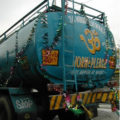I spent the academic year 1985-86 in Benares, India’s holy city on the Ganges, on the University of Wisconsin’s study abroad program. I was the only one of the group of twelve students who had previously been to India, but I was wrong in thinking that that prepared me for Benares. Benares is the concentrated essence of India: teeming, filthy, intense. I was overwhelmed, and to this day I’m a bit surprised that I survived it; I used to run away to Allahabad to visit friends, drink Scotch, and watch videos.
Yet there was great beauty in Benares, beyond the standard boat trips on the Ganges and views of the temples and ghats.
One of our first evenings in Benares, some teammates and I decided to explore. We got lost almost immediately, and were a bit frightened, as well as beseiged by hawkers wanting us to look at this and that shop of tourist goods (they didn’t know we were poor students). We decided to go into a silk shop, to get everyone else off our backs for a while. This was the ground floor of a home made of whitewashed concrete, with wooden double doors and window frames painted blue or green. We took off our shoes and were ushered into the sales area, where the floor was completely covered by a white mattress, with white pillows to lean on. We were given hot, sweet, milky tea. Then the lights went out – one of Benares’ numerous power cuts. But kerosene lanterns were brought, and by their flaring golden light the shopkeeper began displaying his wares.
Benares is famous for its silks, richly colored and brocaded, with gold or silver borders. He flung out silk scarves so that they exploded into our laps like a fireworks display: magenta, scarlet, royal blue, parrot green – color after color, pattern after pattern. Scarves of all different sizes, then cushion covers and shawls. Had we been Indian women, we would have seen saris as well, or probably first. (Towards the end of my stay I did buy a Banarsi silk sari, to wear to a friend’s wedding; it took weeks to track down exactly the right shade of peacock blue, with a silver and black border. I only wore it the once, but I still have it.)
We didn’t buy anything that night, but the shopkeeper didn’t seem to mind, nor to feel that he’d wasted tea on us. We praised his silks as extravagantly as they deserved, and thanked him profusely, and he was very kind. Eventually we got away and found our way home. After that, I wasn’t so nervous about exploring Benares. People were usually pleasant; it helped that I spoke Hindi fluently.
I loved the gallis: the old, narrow, twisty streets, where the considerable flow of human, bicycle, and scooter traffic could be stopped dead by a cow suddenly deciding to have a lie-down. A galli is only about as wide as your outstretched arms can reach, but it’s as crowded as 5th Avenue, and similarly lined with shops. Except that these shops are reached by climbing up a few wooden steps, so that when you’re in the shop you look out and slightly down onto the crowd. There’s usually no glass window, so you can hear and smell the traffic as well as see it. It’s like having a ringside seat at the circus.
My favorite was the bangle shop, selling traditional glass bangles in thousands of colors and patterns. I visited so often that the bangle-wallah and I became friends. He was delighted that I would eat paan and drink lassi or tea. Paan is betel nut, served minced with lime (calcium) paste and spices, folded up in a fresh green paan leaf. You pop the whole thing into your mouth and chew it. I always had mitha (sweet) paan, without tobacco. Paan is supposed to have a mildly stimulating effect, but I never noticed it, perhaps because I was already so stimulated by my surroundings. It has an astringent flavor, and produces quantities of brick red saliva that you have to spit into the street (hence the red splashes you see everywhere in India). Lassi is a yogurt drink that can be sweet or salted, very refreshing in hot weather. (Yes, I probably picked up lots of parasites this way; hot tea is a lot safer.)
The bangle-wallah and I would sit for hours, chatting and watching the tourists. He found it hilarious that adult male Americans would wear shorts in public: “In India, only boys wear shorts!” Buying bangles was almost an afterthought; I chose them carefully to match the colors of my salwar-kameez (pants and tunic) outfits. The walls of the shop were lined with horizontal wooden rods, each covered from end to end in bangles: plain glass, mirror glass, cut glass, worked glass, twisted glass, glass with gold or silver accents… You wear at least a dozen per arm, and they tinkle delightfully as you move and they gently clash together. Yes, in the end they all break – then you just get more!
I had so many bangles that I bought my own wooden rod, which I propped between a big tin trunk and a shelf in my room. One of my going away to Benares presents had been a rich lanolin soap in the shape of Alice’s Cheshire Cat; I kept it on the shelf when I wasn’t bathing. One night I heard my bangles tinkling on their rod. I snapped on the light, and saw a scurry and a whisk as a rat ran out of sight. He had climbed up the trunk and then run across the bangles to gnaw on the soap; I guess lanolin tastes good to a rat. So the rat was eating the Cat.
Nostalgia link: musicians from my Benares days



